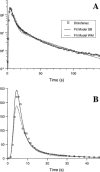Cytoplasmic binding and disposition kinetics of diclofenac in the isolated perfused rat liver
- PMID: 10903973
- PMCID: PMC1572206
- DOI: 10.1038/sj.bjp.0703448
Cytoplasmic binding and disposition kinetics of diclofenac in the isolated perfused rat liver
Abstract
1. The binding kinetics of diclofenac to hepatocellular structures were evaluated in the perfused rat liver using the multiple indicator dilution technique and a stochastic model of organ transit time density. 2. The single-pass, in situ rat liver preparation was perfused with buffer solution (containing 2% albumin) at 30 ml min(-1). Diclofenac and [(14)C]-sucrose (extracellular reference) were injected simultaneously as a bolus dose into the portal vein (six experiments in three rats). An analogous series of experiments was performed with [(14)C]-diclofenac and [(3)H]-sucrose. 3. The diclofenac outflow data were analysed using three models of intracellular distribution kinetics, assuming (1) instantaneous distribution and binding (well-mixed model), (2) 'slow' binding at specific intracellular sites after instantaneous distribution throughout the cytosol (slow binding model), and (3) 'slowing' of cytoplasmic diffusion due to instantaneous binding (slow diffusion model). 4. The slow binding model provided the best description of the data. The rate constants for cellular influx and sequestration were 0.126+/-0. 026 and 0.013+/-0.009 s(-1), respectively. The estimated ratio of cellular initial distribution volume to extracellular volume of 2.82 indicates an almost instantaneous distribution in the cellular water space, while the corresponding ratio of 5.54 estimated for the apparent tissue distribution volume suggests a relatively high hepatocellular binding. The non-instantaneous intracellular equilibration process was characterized by time constants of the binding and unbinding process of 53.8 and 49.5 s, respectively. The single-pass availability of diclofenac was 86%. The results obtained with [(14)C]-diclofenac and [(3)H]-sucrose were not statistically different.
Figures




Similar articles
-
Demonstration of rapid entry and a cellular binding space for salicylamide in perfused rat liver: a multiple indicator dilution study.J Pharmacol Exp Ther. 1994 Jul;270(1):285-95. J Pharmacol Exp Ther. 1994. PMID: 8035326
-
Structure-hepatic disposition relationships for cationic drugs in isolated perfused rat livers: transmembrane exchange and cytoplasmic binding process.J Pharmacol Exp Ther. 2001 May;297(2):780-9. J Pharmacol Exp Ther. 2001. PMID: 11303070
-
Disposition kinetics of diclofenac in the dual perfused rat liver.J Pharm Sci. 2013 Sep;102(9):3220-7. doi: 10.1002/jps.23564. Epub 2013 Apr 23. J Pharm Sci. 2013. PMID: 23613004
-
Hepatic uptake of bromosulfophthalein-glutathione in perfused Eisai hyperbilirubinemic mutant rat liver: a multiple-indicator dilution study.J Pharmacol Exp Ther. 1998 Feb;284(2):480-92. J Pharmacol Exp Ther. 1998. PMID: 9454788
-
Hepatic clearance models: comparison of the dispersion and Goresky models in outflow profiles from multiple indicator dilution rat liver studies.Drug Metab Dispos. 1998 May;26(5):465-75. Drug Metab Dispos. 1998. PMID: 9571228 Review.
Cited by
-
Characterization of the physiological spaces and distribution of tolbutamide in the perfused rat pancreas.Pharm Res. 2007 Mar;24(3):512-20. doi: 10.1007/s11095-006-9167-2. Pharm Res. 2007. PMID: 17252192
-
Hepatic pharmacokinetics of taurocholate in the normal and cholestatic rat liver.Br J Pharmacol. 2005 May;145(1):57-65. doi: 10.1038/sj.bjp.0706148. Br J Pharmacol. 2005. PMID: 15711588 Free PMC article.
-
Effects of dose, flow rate, and bile acid on diclofenac disposition in the perfused rat liver.Eur J Drug Metab Pharmacokinet. 2016 Jun;41(3):301-7. doi: 10.1007/s13318-015-0259-4. Epub 2015 Feb 6. Eur J Drug Metab Pharmacokinet. 2016. PMID: 25656736
-
Fractal structure of the liver: effect on drug elimination.J Pharmacokinet Pharmacodyn. 2013 Feb;40(1):11-4. doi: 10.1007/s10928-012-9283-z. Epub 2012 Dec 5. J Pharmacokinet Pharmacodyn. 2013. PMID: 23212277
-
Hepatocellular necrosis, fibrosis and microsomal activity determine the hepatic pharmacokinetics of basic drugs in right-heart-failure-induced liver damage.Pharm Res. 2012 Jun;29(6):1658-69. doi: 10.1007/s11095-012-0690-z. Pharm Res. 2012. PMID: 22302523
References
-
- BARLOW J.W., CURTIS A.J., RAGGATT L.E., LOIDL N.M., TOPLISS D.J., STOCKIGT J.R. Drug competition for intracellular triiodothyronine-binding sites. Eur. J. Endocrinol. 1994;130:417–421. - PubMed
-
- CHEUNG K., HICKMAN P.E., POTTER J.M., WALKER N., JERICHO M., HASLAM R., ROBERTS M.S. An optimised model for rat liver perfusion studies. J. Surg. Res. 1996;66:81–89. - PubMed
-
- CRANK J. The Mathematics of Diffusion, 2nd ed. Oxford University Press; 1975.
-
- DIAZ-GARCIA J.M., EVANS A.M., ROWLAND M. Application of the axial dispersion model of hepatic drug elimination to the kinetics of diazepam in the isolated perfused rat liver. J. Pharmacokin. Biopharm. 1992;20:171–193. - PubMed
-
- EVANS A.M., HUSSEIN Z., ROWLAND M. A two-compartment dispersion model describes the hepatic outflow profile of diclofenac in the presence of its binding protein. J. Pharm. Pharmacol. 1991;43:709–714. - PubMed
Publication types
MeSH terms
Substances
LinkOut - more resources
Full Text Sources
Miscellaneous

